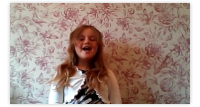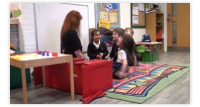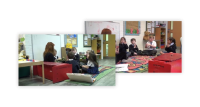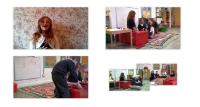Food & Eating Level: Key Stage 1 - Skills & games
Music Lesson Description
Exploring a Xylophone
In the next activity we use a xylophone. We may think it's obvious that the bigger bars on a xylophone make lower sounds but children tend to expect the opposite because their everyday understanding is that higher means louder, as in TV volume. Try allowing exploring time, in which you help the children to work out how to put the bars on in the right order.
Breakfast time! (rhythm, pulse)
Everyone chants the rhyme rhythmically, tapping the pulse on knees - sit in a circle and let the children see you tapping the pulse with big movements which they can copy.
When the chant is known, divide the class into three groups: the Cheese group, the Apple group and the Jelly group,. On the words in capitals, the children invent different movements eg big arms for cheese, little finger circles for peas, scratching for fleas, wings for bees. They rub tummies for the last line.
- It's breakfast time (tap the pulse on knees)
- With words that rhyme (tap the pulse on knees)
- How many can you say? (pretend to count on fingers)
- CHEESE and PEAS and FLEAS and BEES
- That's what we'll eat today! (rub tummies)
- __
- It's breakfast time (tap the pulse on knees)
- With words that rhyme (tap the pulse on knees)
- How many can you say? (pretend to count on fingers)
- APPLE JUICE and STRAWberry MOUSSE
- That's what we'll eat today! (rub tummies)
- __
- It's breakfast time (tap the pulse on knees)
- With words that rhyme (tap the pulse on knees)
- How many can you say? (pretend to count on fingers)
- JELLY ROAST and SLUGS on TOAST
- That's what we'll eat today! (rub tummies)
Extension - Sing and play! (pitch, texture)
1/ Next, ask the children to make up a tune to the rhyme, in pairs. If you use a xylophone, I suggest you take off all the bars except for C, D, E, G and A in a row but missing out the F: a pentatonic (five) group of notes that are easy to sing.
2/ Instead of tapping the pulse on knees, one child from each group could play an untuned instrument, (eg a drum) to accompany the singing. Ask each group to do their verse with the other children listening, then ask the listeners if the singing could be heard well enough above the instruments (this is called balancing the texture).
Extension - Make up an Intro!
First, model how you could make a simple intro to the song by clapping the rhythm of the words: Cheese and peas and fleas and bees, and have the children copy you. Then model how to play that on any instrument. Next, give everyone an instrument, some tuned and some untuned, and put the children into groups of two or three. If you have chime bars, give out two only per group: C and E, or E and G, or G and A. Each group has to make up a little intro that lasts as long as their special line, to play before their verse. Give each group a turn at showing their intro.






